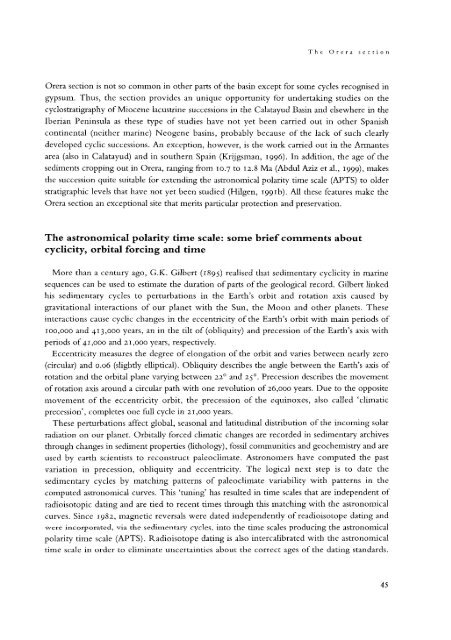The Orera section (Calatayud Basin, NE Spain) - Universiteit Utrecht
The Orera section (Calatayud Basin, NE Spain) - Universiteit Utrecht
The Orera section (Calatayud Basin, NE Spain) - Universiteit Utrecht
Create successful ePaper yourself
Turn your PDF publications into a flip-book with our unique Google optimized e-Paper software.
<strong>The</strong> <strong>Orera</strong> <strong>section</strong><br />
<strong>Orera</strong> <strong>section</strong> is not so common in other parts ofthe basin except for some cycles recognised in<br />
gypsum. Thus, the <strong>section</strong> provides an unique opportunity for undertaking studies on the<br />
cyclostratigraphy ofMiocene lacustrine successions in the <strong>Calatayud</strong> <strong>Basin</strong> and elsewhere in the<br />
Iberian Peninsula as these type of studies have not yet been carried out in other Spanish<br />
continental (neither marine) Neogene basins, probably because of the lack of such clearly<br />
developed cyclic successions. An exception, however, is the work carried out in the Armantes<br />
area (also in <strong>Calatayud</strong>) and in southern <strong>Spain</strong> (Krijgsman, 1996). In addition, the age of the<br />
sediments cropping out in <strong>Orera</strong>, ranging from 10.7 to 12.8 Ma (Abdul Aziz et al., 1999), makes<br />
the succession quite suitable for extending the astronomical polarity time scale (APTS) to older<br />
stratigraphic levels that have not yet been studied (Hilgen, 1991b). All these features make the<br />
<strong>Orera</strong> <strong>section</strong> an exceptional site that merits particular protection and preservation.<br />
<strong>The</strong> astronomical polarity time scale: some briefcomments about<br />
cyclicity, orbital forcing and time<br />
More than a century ago, G.K. Gilbert (1895) realised that sedimentary cyclicity in marine<br />
sequences can be used to estimate the duration ofparts ofthe geological record. Gilbert linked<br />
his sedimentary cycles to perturbations in the Earth's orbit and rotation axis caused by<br />
gravitational interactions of our planet with the Sun, the Moon and other planets. <strong>The</strong>se<br />
interactions cause cyclic changes in the eccentricity ofthe Earth's orbit with main periods of<br />
100,000 and 413,000 years, an in the tilt of (obliquity) and precession of the Earth's axis with<br />
periods of41,000 and 21,000 years, respectively.<br />
Eccentricity measures the degree of elongation of the orbit and varies between nearly zero<br />
(circular) and 0.06 (slightly elliptical). Obliquity describes the angle between the Earth's axis of<br />
rotation and the orbital plane varying between 22° and 25°. Precession describes the movement<br />
of rotation axis around a circular path with one revolution of26,000 years. Due to the opposite<br />
movement of the eccentricity orbit, the precession of the equinoxes, also called 'climatic<br />
precession', completes one full cycle in 21,000 years.<br />
<strong>The</strong>se perturbations affect global, seasonal and latitudinal distribution of the incoming solar<br />
radiation on our planet. Orbitally forced climatic changes are recorded in sedimentary archives<br />
through changes in sediment properties (lithology), fossil communities and geochemistry and are<br />
used by earth scientists to reconstruct paleoclimate. Astronomers have computed the past<br />
variation in precession, obliquity and eccentricity. <strong>The</strong> logical next step is to date the<br />
sedimentary cycles by matching patterns of paleoclimate variability with patterns in the<br />
computed astronomical curves. This 'tuning' has resulted in time scales that are independent of<br />
radioisotopic dating and are tied to recent times through this matching with the astronomical<br />
curves. Since 1982, magnetic reversals were dated independently of readioisotope dating and<br />
were incorporated, via the sedirr>ent:J.ry cycles. into the tilne scales producing the astronomical<br />
polarity time scale (APTS). Radioisotope dating is also intercalibrated with the astronomical<br />
time scale in order to eliminate uncertainties about the correct ages of the dating standards.<br />
45

















